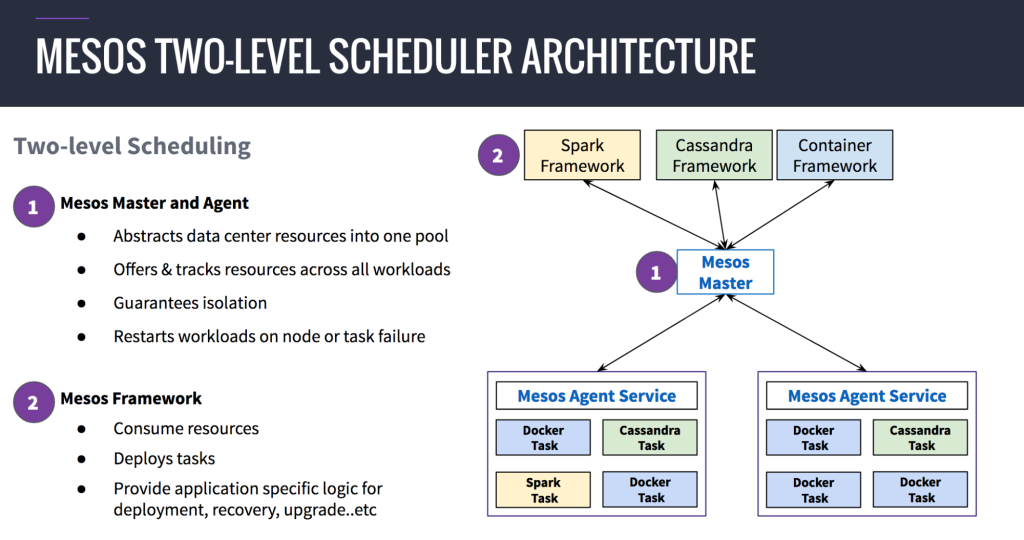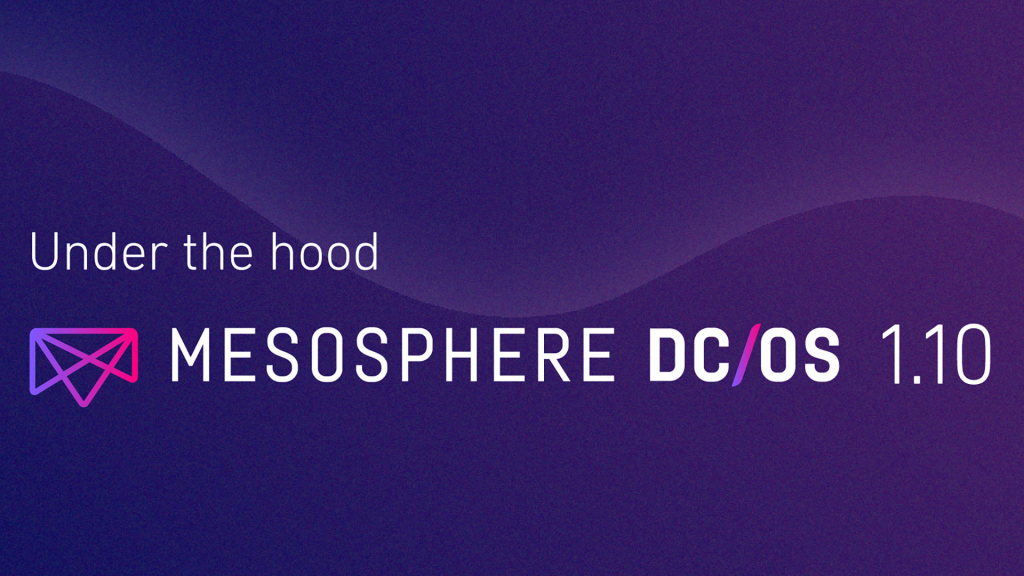What is Mesosphere?

Mesosphere is an open-source platform for managing and running distributed systems. It provides a set of tools and services that make it easy to deploy, scale, and manage containerized applications across a cluster of machines. Mesosphere was founded in 2010 by Benjamin Hindman, Edwin Shafer, and Florian Leippold. In 2016, Mesosphere acquired Marathon, a container orchestration platform, and DC/OS, a distributed operating system. Mesosphere was then acquired by SUSE in 2017.
Mesosphere is based on Apache Mesos, an open-source cluster manager that provides a distributed resource abstraction layer. Mesos allows applications to share resources across a cluster of machines in a flexible and efficient way. On top of Mesos, Mesosphere provides a number of additional features, including:
- Marathon: A container orchestration platform that makes it easy to deploy and manage containerized applications.
- DC/OS: A distributed operating system that provides a set of services for managing clusters, including networking, security, and storage.
- Chronos: A distributed job scheduler that can be used to schedule batch jobs and long-running processes.
- Registry: A service discovery framework that makes it easy to find and connect to services running in a cluster.
Mesosphere is a popular platform for running large-scale, distributed applications. Some of the companies that use Mesosphere include Uber, Netflix, and Airbnb.
Top 10 use cases of Mesosphere?
Here are the top 10 use cases of Mesosphere:
- Microservices architecture: Mesosphere can be used to deploy and manage microservices applications, which are made up of small, independent services that can be easily scaled and updated.
- Big data processing: Mesosphere can be used to run big data processing frameworks, such as Apache Spark and Apache Hadoop, at scale.
- Machine learning: Mesosphere can be used to train and run machine learning models at scale.
- Continuous integration and continuous delivery (CI/CD): Mesosphere can be used to automate the CI/CD pipeline, which allows developers to quickly and easily deploy new versions of their applications.
- Internet of Things (IoT): Mesosphere can be used to manage and process data from IoT devices.
- High-performance computing (HPC): Mesosphere can be used to run HPC applications at scale.
- Cloud-native applications: Mesosphere can be used to deploy and manage cloud-native applications, which are designed to be portable and scalable across different cloud environments.
- Legacy application modernization: Mesosphere can be used to modernize legacy applications by containerizing them and running them on a distributed platform.
- Edge computing: Mesosphere can be used to run applications at the edge of the network, closer to the data sources.
- Serverless computing: Mesosphere can be used to run serverless applications, which are applications that are managed by a cloud provider and do not require any infrastructure management on the part of the developer.
What are the feature of Mesosphere?
Key Features of Mesosphere:
Resource Management:
- Apache Mesos: At its core, Mesosphere leverages Mesos, providing a distributed resource abstraction layer that efficiently shares resources (CPU, memory, storage) across a cluster of machines.
- Marathon: Offers container orchestration for deploying and managing containerized applications at scale. It automates tasks like starting, stopping, scaling, and upgrading containers.
- DC/OS: Acts as a distributed operating system, offering services for networking, security, storage, and cluster management, simplifying and centralizing these tasks.
Job Scheduling and Automation:
- Chronos: This distributed job scheduler handles scheduled batch jobs and long-running processes, coordinating and scaling them across the cluster seamlessly.
- Framework Integration: Mesosphere integrates with popular frameworks like Docker, Spark, Hadoop, and Kafka, ensuring compatibility with your existing ecosystem.
Additional Features:
- Service Discovery: Registry facilitates service discovery within the cluster, allowing applications to easily find and connect to other services needed.
- Monitoring and Visualization: Mesosphere provides tools for monitoring and visualizing cluster health, application performance, and resource utilization.
- Security and Access Control: Secure access control ensures authorized individuals can manage and access resources and applications within the platform.
Overall Benefits:
- Scalability: Easily scale applications horizontally by adding more machines to the cluster.
- Flexibility: Run diverse workloads, from containerized applications to big data processing to AI/ML models.
- Automation: Automate infrastructure management and application deployments, increasing efficiency.
- Open Source: Mesosphere is primarily open-source, offering transparency and customization options.
Remember, Mesosphere was acquired by SUSE in 2017, and its roadmap and feature development have evolved since then.
How Mesosphere works and Architecture?

Mesosphere, though now part of SUSE, was an open-source platform for managing and running distributed systems. While its development has concluded, understanding its architecture and how it worked can still be valuable. Here’s a breakdown:
Mesosphere is a layered architecture built on two core components:
1. Apache Mesos: This open-source cluster manager forms the foundation. It provides a distributed resource abstraction layer, essentially acting as a virtual pool of resources (CPU, memory, storage) across the cluster. Applications request resources from Mesos, which dynamically allocates them based on availability and priorities.
2. Mesosphere Services: On top of Mesos, Mesosphere offered various services to manage different aspects of distributed applications:
- Marathon: A container orchestration platform like Kubernetes. It enables deploying, managing, and scaling containerized applications across the cluster.
- DC/OS: A distributed operating system offering services for networking, security, storage, and cluster management, simplifying common tasks.
- Chronos: A distributed job scheduler for scheduling batch jobs and long-running processes across the cluster.
- Registry: A service discovery framework allowing applications to easily find and connect to other services within the cluster.
Additional Components:
- Mesosphere UI: A user interface for managing and monitoring resources, applications, and services within the cluster.
- Mesos Frameworks: Frameworks like Spark and Docker could integrate with Mesos to leverage its resource management capabilities.
How Mesosphere Worked:
- Application Deployment: Applications submitted resource requests to Marathon, which orchestrated container deployment on available nodes managed by Mesos.
- Resource Allocation: Mesos received resource requests and allocated available resources across the cluster based on configured policies and priorities.
- Scaling and Fault Tolerance: Marathon could autoscale applications based on metrics or user-defined conditions. Mesos handled node failures by rescheduling tasks on other available nodes.
- Job Scheduling: Chronos scheduled and coordinated batch jobs and long-running processes, leveraging Mesos for resource allocation.
- Service Discovery: Registry facilitated service discovery by maintaining a registry of available services, allowing applications to locate and connect to them dynamically.
Benefits of Mesosphere Architecture:
- Scalability: Ability to easily scale applications and infrastructure horizontally by adding more nodes to the cluster.
- Flexibility: Supported diverse workloads, from containerized applications to big data processing to AI/ML models.
- Resource Optimization: Efficient resource utilization due to centralized resource management by Mesos.
- Automation: Automated deployments, scaling, and job scheduling through Marathon and Chronos.
As mentioned earlier, Mesosphere development has concluded. While it remains a valuable learning resource, the current offerings and roadmap are managed by SUSE.
How to Install Mesosphere it?
There are two main approaches to installing Mesosphere:
1. Installing Pre-Built Packages:
This is the easiest method for individual servers or testing purposes. Here are the options:
Linux:
- Ubuntu/Debian:
- Add the Mesosphere repository key:
sudo apt-key adv --keyserver keyserver.ubuntu.com --recv E56151BF - Update package lists:
sudo apt-get update - Install Mesosphere package:
sudo apt-get install mesos
- Add the Mesosphere repository key:
- CentOS/RHEL:
- Add the Mesosphere repository:
sudo yum install -y https://repos.mesosphere.com/el/7/noarch/mesosphere-repo-el7-7.noarch.rpm - Install Mesosphere:
sudo yum install -y mesos
- Add the Mesosphere repository:
macOS:
- Use Homebrew:
brew install mesos
Windows:
- Download the official package installer from the Mesosphere website.
2. Building from Source:
This method offers more flexibility and customization but requires advanced technical knowledge:
- Prerequisites:
- Linux (64-bit) or macOS (64-bit)
- GCC 4.8.1+ or Clang 3.5+
- Autotools
- OpenJDK 7+
- Download and extract source code: https://github.com/apache/mesos.
- Configure and build: Follow the detailed instructions in the Mesosphere site:
Notes:
- Cluster Configuration: After installing Mesosphere on individual nodes, you need to configure them as a cluster for distributed functionality.
- ZooKeeper: Mesosphere often uses ZooKeeper for coordination. Depending on your chosen installation method, additional configuration might be necessary.
- Choose the right method: Select the method that aligns with your technical expertise and specific needs. Pre-built packages are faster for basic setups, while building from source offers more control and customization.
Always keep in mind, detailed instructions and specific requirements can vary depending on your chosen operating system, version, and desired configuration.
Basic Tutorials of Mesosphere: Getting Started

To provide a step-by-step tutorial of using Mesosphere, a popular open-source distributed systems platform, please follow the instructions below:
- Installation:
- Visit the official Mesosphere website to download the installation package suitable for your operating system.
- Follow the installation instructions specific to your OS to set up Mesosphere on your machine.
2. Launching Mesosphere:
- After installing Mesosphere, open your terminal or command prompt.
- Execute the command to start Mesosphere:
mesos-master. - This command launches the Mesos master process which manages distributed resources.
3. Setting up Mesos Agents:
- In a new terminal or command prompt window, execute the command:
mesos-agent --master=<IP_ADDRESS_OF_MESOS_MASTER>. - Replace
<IP_ADDRESS_OF_MESOS_MASTER>with the actual IP address of your Mesos master. - This command starts the Mesos agent process, allowing it to communicate with the Mesos master and offer computing resources.
4. Running Tasks:
- To run a task on Mesosphere, you need to create a task definition. A task definition typically includes details such as the container image, resources required, command to execute, etc.
- Write a task definition in a file (e.g.,
task.json) using JSON format. - Submit the task to Mesos using the following command:
mesos-execute --master=<IP_ADDRESS_OF_MESOS_MASTER> --task=file://<PATH_TO_TASK_DEFINITION_FILE>. - Replace
<IP_ADDRESS_OF_MESOS_MASTER>with the IP address of your Mesos master, and<PATH_TO_TASK_DEFINITION_FILE>with the actual path to your task definition file.
5. Monitoring and Managing Mesos:
- To monitor the Mesos cluster, you can access the Mesos web interface by opening a browser and navigating to
<IP_ADDRESS_OF_MESOS_MASTER>:5050. - This interface provides detailed information about the cluster’s health, resource allocation, running tasks, etc.
6. Scaling and Managing Applications:
- Mesosphere offers different tools such as Marathon and Chronos for managing and scaling applications.
- Marathon handles long-running applications and services while Chronos focuses on scheduled jobs.
Say goodbye to the hassles of bike ownership! MotoShare.in offers affordable rentals, whether you need a scooter for errands, a bike for a road trip, or a reliable ride to explore new cities.

 Starting: 1st of Every Month
Starting: 1st of Every Month  +91 8409492687
+91 8409492687  Contact@DevOpsSchool.com
Contact@DevOpsSchool.com
